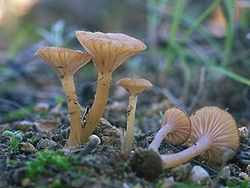Contumyces
| Contumyces | |
|---|---|
 | |
| Contumyces rosellus | |
| Scientific classification | |
| Kingdom: | Fungi |
| Subkingdom: | Dikarya |
| Phylum: | Basidiomycota |
| Subphylum: | Agaricomycotina |
| Class: | Agaricomycetes |
| Order: | Hymenochaetales |
| Family: | Repetobasidiaceae |
| Genus: | Contumyces Redhead, Moncalvo, Vilgalys & Lutzoni |
| Type species | |
| Contumyces rosellus (M.M. Moser) Redhead, Moncalvo, Vilgalys & Lutzoni | |
Contumyces is a genus of brightly colored bryophilous agarics in the Hymenochaetales that have an omphalinoid morphology, and therefore were previously classified in Omphalina.[1][2] They inhabit mossy silty or sandy soils in the Northern Hemisphere. Phylogenetically related agarics are in the genera Rickenella, Gyroflexus, Loreleia, Cantharellopsis and Blasiphalia, as well as the stipitate-stereoid genera Muscinupta and Cotylidia[3] and clavaroid genus, Alloclavaria.[4] Contumyces is most similar to Rickenella and Blasiphalia and differs by having its cystidia on the pileus, stipe, and hymenium in clusters, whereas in Rickenella and Blasiphalia the cystidia are solitary.
Etymology
Contumyces is named after the contemporary amateur Italian mycologist, Marco Contu, and is a replacement for the illegitimate generic name Jacobia, so named after Jakob Emanuel Lange by Contu, but unfortunately a latter homonym of Jacobea, a genus of flowering plants.
References
- ↑ Redhead, S.A. et al. (2002a). "Phylogeny of agarics: partial systematics solutions for bryophilous omphalinoid agarics outside of the Agaricales (euagarics)". Mycotaxon 82: 151–168.
- ↑ Redhead, S.A. et al. (2002b). "Phylogeny of agarics: partial systematics solutions for core omphalinoid genera in the Agaricales (euagarics)". Mycotaxon 83: 19–57.
- ↑ Larsson, K.-H. et al. (2006) [2007]. "Hymenochaetales: a molecular phylogeny for the hymenochaetoid clade". Mycologia 98 (6): 926–936. doi:10.3852/mycologia.98.6.926. PMID 17486969.
- ↑ Dentinger, B.T.M. & McLaughlin, D.J. (2006). "Reconstructing the Clavariaceae using nuclear large subunit rDNA sequences and a new genus segregated from Clavaria". Mycologia 98 (5): 746–762. doi:10.3852/mycologia.98.5.746. PMID 17256578.
External links
- Contumyces in Index Fungorum.
- Contumyces in MycoBank.